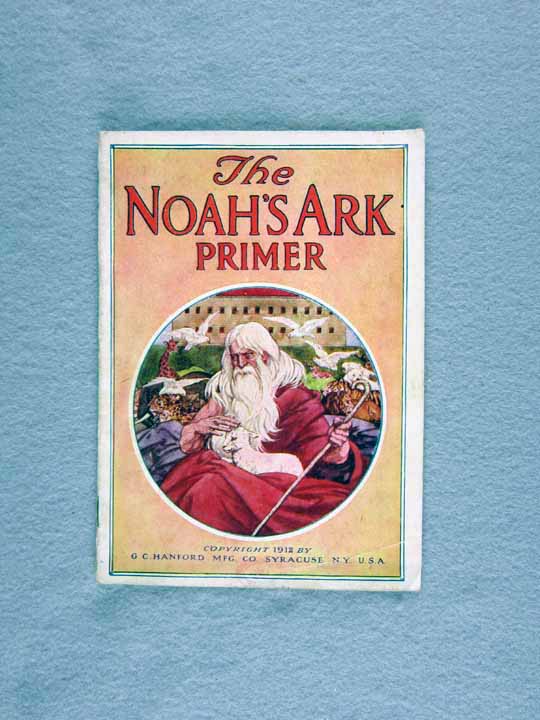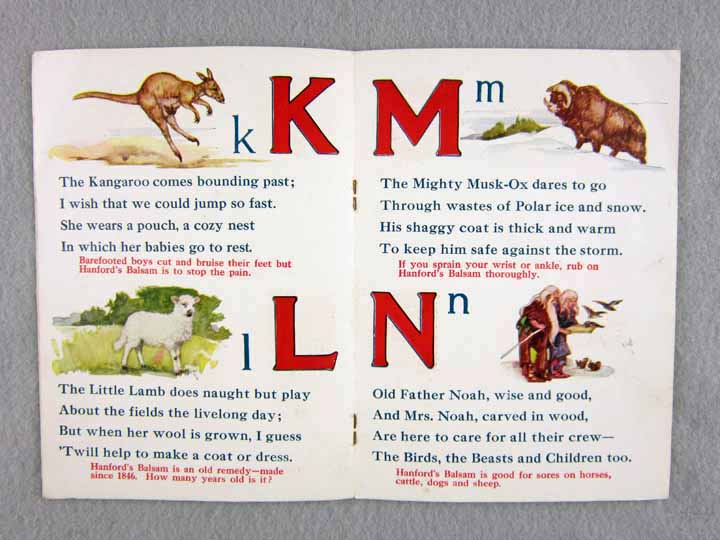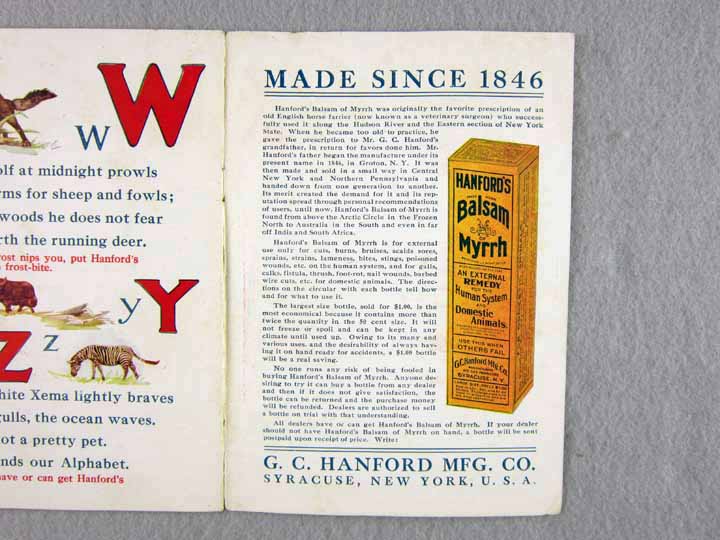

Alphabet books offer a vivid insight into the history of literacy and culture, as well as concepts of childhood. The Children's Book Collection at UCLA contains a rich array of these materials, some well-worn and much-used, some still bright and fresh. Each is a gem of print production and graphical imagery from another time and place. Though the history of alphabet books continues to the present, this exhibit focuses on the works in our collections published between 1700 and 1900, including horn books, primers, works of didacticism and seriousness, whimsy and play.
2. A Jumble ABC
3. A Little Pretty Pocket-Book
4. A New Lottery Book of Birds And Beasts
5. A Pretty Play-Thing for Children of All Denominations
8. ABC of Objects for Home And School
10. ABC with Pictures & Verses
12. Alphabet Et Instruction Pour Les Enfans
16. Dolly's ABC Book
17. Flora's ABC
18. Home ABC
22. Hornbook C. 1700
23. Large Letters for the Little Ones
24. Little ABC Book
25. Little People: An Alphabet
26. Martin's Nursery Battledoor
27. Mother Goose ABC
28. My Darling's ABC
29. Orbis Sensualium Pictus Quadrilinguis
30. People of All Nations: A Useful Toy for Girl Or Boy
31. Picture Alphabet
32. Pretty ABC
33. Railway ABC
34. Rusher's Reading Made Most Easy
38. The Alphabet of Old Friends
40. The Amusing Alphabet for Young Children Beginning To Read
42. The Child's Christian Education
45. The Easter Gift
47. The Favorite Alphabet for the Nursery
49. The Franklin Alphabet And Primer
51. The Golden ABC
55. The Moral And Entertaining Alphabet
57. The Old Testament Alphabet
59. The Picture Alphabet for Little Children
62. The Sunday ABC
63. The Union ABC
64. The Young Child's ABC, Or, First Book
65. Tom Thumb's Alphabet: Picture Baby-Books
67. Warne's Alphabet And Word Book: with Coloured Pictures
68. Wood's Royal Nursery Alphabet
Title The Noah's Ark Primer



Brief description Noah's Ark-themed alphabet book. Includes upper and lower case letters, each has a corresponding image and four-lined clerihew with the rhyme scheme of A-A-B-B. Also contains advertisement blurbs for each letter that showcase Hanford's Balsam of Myrrh. 12 paper pages, 5 in x 7 in, bound with staples.
Full description The Noah's Ark Primer is a humor and practical book that presents the ABCs using animals and characters from the biblical flood narrative. Along with colorful images, several lines of rhythmic prose accompany each letter. Similar to the size of a chapbook, The Noah's Ark Primeris printed on paper and bound with staples. The book was produced by the G.D. Hanfrod Manufacturing Copany as an advertising tool for Hanford's Balsam, a topic treatment for human and animal injuries. Beneath each simple poem for every letter is a short statement explaining the benefits of Hanford's Balsam
Literacy At the turn of the 20th century, explicit moral lessons in children's books were rapidly becoming outmoded, which is clearly demonstrated in The Noah's Ark Primer. Contrary to the title, which suggests religious literacy, the book is a humorous and practical literacy tool. The Noah's Ark Primer is a unique book because of its use of biblical narrative for advertisement purposes. Each letter is paired with a representative animal or character from Noah's Ark, a set of two couplets, and a sentence explaining briefly the benefits of using Hanford's Balsam, an antiseptic balm made of myrrh used as an external remedy for the human system and domestic animals. For example, letter N: "Old Father Noah, wise and good / and Mrs. Noah, carved in wood / Are here to care for all their crew / The birds, the beasts, and children too," includes the statement, "Hanford's Balsam is good for sores on horses, cattle, dogs, and sheep." Or consider "K for Kangaroo who wears a pouch, a cozy nest in which her babies rest," and the accompanying statement, "Barefooted boys cut and bruise their feet, but Hanford's Balsam is to stop the pain." These advertisements teach functional literacy, or knowledge required to get along successfully on a day-to-day basis. This shows that by 1912--the year The Noah's Ark Primer was published--children had been identified as something other than unsaved souls in need of religious literacy. Children were identified as future consumers, and were consequently in need of functional literacy as potential participants in the American economy.
Childhood After the turn of the 20th century, the concept of childhood was fully developed and had directly affected the development of an emerging economy centered on children's literature. This is clearly demonstrated by the The Noah's Ark Primer, which, contrary to the religious tone of the title, is in fact--in addition to being humorous, practical and educational-- essentially a targeted advertisement. The tidbit of information included with rhythmic couplets related to each letter is an explicit advertisement for Hanford's Balsam, an antiseptic balm made of myrrh. The inclusion of an advertisement like this demonstrates that the development of "childhood" had opened opportunities for making profit off the children's book industry, which had developed over the past century. This point is key, as it shows that in 1912, the year Noah's Ark Primer was published, children had been identified as something other than small adults, unsaved souls, or future airs of the estate. Children became future consumers. A book like Noah's Ark Primer allows childhood during this period to be understood as quite changed from the previously well-instated ideas of childhood as a time of innocence, or vital opportunity to learn and embrace religion; instead children were beginning to be understood as an important--although distinct from adults--type of American consumer and consequently active participants in the development of the economy.
Iconography The mixture of religious iconography from the biblical story of Noah's Ark and the commercial advertising overtone creates an interesting set of cultural iconography in The Noah's Ark Primer. The result is an unintended dialog between a narrative of materialism and religious narrative. The variety of animal and ark imagery can be viewed as icons that religiously symbolize new beginnings and a covenant with God, however this book utilizes them to represent uses for their product and for persuading readers to purchase Hanford's Balsam.
Production The Noah's Ark Primer provides evidence of a odd instance in children's literature publishing at the turn of the twentieth century. The G.C. Hanford Manufacturing Company, was not a book publisher, but rather the manufacturer of Hanford's Balsam, a lineament treatment made of Myrrh for the "human system and domestic animals." The history of the company, located inside the back cover of the book, may seem like a strange detail to find inside of a child's alphabet book. However, the history provides evidence that retailers outside of the children's literature publishing industry were motivated to take advantage of the audience captured by alphabet books and took advantage of the opportunity to advertise to young readers and their families.
Publisher G. C. Hanford Mfg. Co.
Publication place Syracuse
Date 1912
UCLA Call Number BS658 N6333 1912
Repository UCLA Charles E. Young Research Library, Dept. of Special Collections
Dimensions 5 in x 7 in
Technologies of production Printing
Media and Materials Paper
Caption